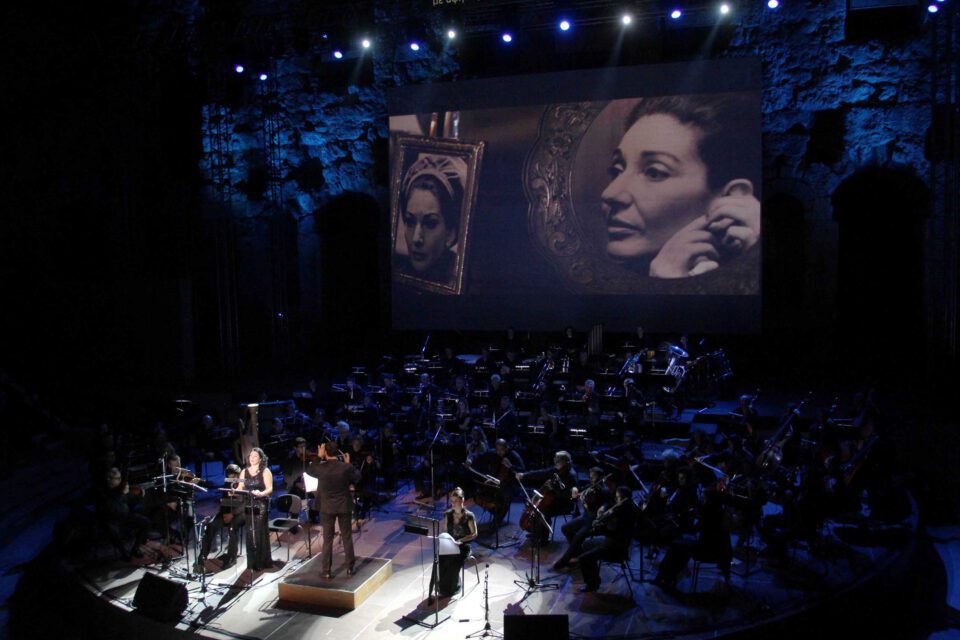As a special supplement of the Athens Epidaurus Festival (1 June – 31 August 2015) and to mark the Athens Democracy Forum (ADF), the magnificent Odeon of Herodes Atticus theatre hosted a musical evening – or “symphonic visual concert”, according to the brochure – on 15 September 2015. The Odeon of Herodes Atticus, known to locals as “Irodio”, is a gigantic amphitheatre dating back to 161 AD, restored in the 1950s with pentelic marble, which seats more than 5000 people.
It was in this setting, beneath the night sky and the Acropolis, that Canadian-American singer and composer Rufus Wainwright’s Prima Donna was staged in an altered format. Instead of the opera as it was originally written, premiering at the Manchester International Festival in 2009, Greece witnessed the Athens State Orchestra (directed by George Petrou) and lyric singers Cellia Costea (soprano), Vassiliki Karayanni (soprano) and Antonio Figueroa (tenor) rendering selected scenes from the production, accompanied by a film that supplied the “visual” part of this symphonic concert. Prima Donna is a love story centred around a former opera star preparing for a comeback with nervous anticipation, having been written off by critics and forgotten by audiences. The French libretto, for which Wainwright collaborated with Bernadette Colomine, and Greek surtitles made the opera slightly inaccessible to an international audience, but as the cliché goes, music has no language.
The emotional range of the music was supplemented by moving images that played out on a screen behind the orchestra: a gloved hand caressing the face of a mannequin, interspersed with scenes of fountains and gardens reminiscent of YouTube videos, and framed photos of celebrated American-born Greek soprano Maria Callas. Often referred to as “la divina”, Callas’ career as an artist was sometimes overshadowed by the media’s obsession with her personal life; nonetheless, her contribution to music and performance remains unparalleled. In 2007, she was posthumously awarded a Grammy Lifetime Achievement Award.
The film was especially created for the concert by Italian filmmaker Francesco Vezzoli with American photographer and director Cindy Sherman. During the final aria, it transforms into an arthouse style portrayal of “the cult of the diva”, as Wainwright says – more precisely, snapshots of Callas’ personal life and performances. Wainwright has previously mentioned an interview with Callas as the inspiration behind Prima Donna, and Callas herself performed at the Irodio in 1957. Despite her Greek roots, she had not previously been given the recognition she deserved; but in 2014, the Greek National Opera raised money and announced plans to open an academy and museum in her honour.
In the film, Callas is played by Sherman, and both Wainwright and Vezzoli play supporting characters. Towards the end of the operatic performance comes the moving climax of the film, the message toward which it has all been heading: an older Callas watches her younger self in all her glory before beginning to wipe off her make-up and blow out all the candles that surround her, one by one. As the music dies, Callas collapses into a chair, wearied, and blows out one last candle that stands beside a photograph from her youth.
In the second half of the concert, Wainwright made an appearance to perform some of his own musical hits, theatrics, folk songs, and even some Mozart, joined by sopranos Costea and Karayanni, tenor Figueroa, and Greek singer Nena Venetsanou. The concert ended with a rendition of Leonard Cohen’s “Anthem”, which Wainwright dedicated to the refugees who are seeking out Europe for a chance at life. Candles that have been extinguished can sometimes be re-lighted.
Kriti Bajaj
For more information vist www.greekfestival.gr.
Follow us on Twitter @AestheticaMag for the latest news in contemporary art and culture.
Credits
1. Rufus Wainwright’s Prima Donna, 2015. Photo by Thomas Daskalakis.



